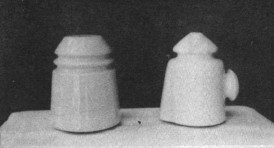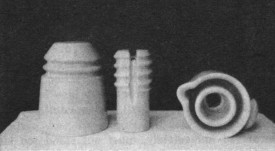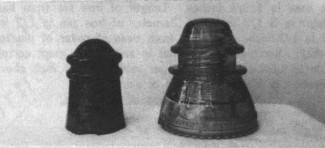Foreign Insulators
by Marilyn Albers
Reprinted from "Crown Jewels of the Wire", October 1985, page 15
Care for Cream with Your (Dry) Spot of Tea?
Let's look at two white porcelain "dry-spot" insulators that were
found in England and which, very appropriately, have nicknames.
In the first photo you will see the "tea mug" on the left.
According to Mr. Alex Burnett (Vermilion, Alberta), the story is that British
linemen used these insulators to drink their tea during the construction of the
line. It would be hard to prove that this is a true story, but just for fun, why
not? Simply unscrew the porcelain inner skirt (shed) and presto!! a spot of hot
tea from a ready made cup! Knowing that the British are very particular about
their tea, (i.e., it must be served immediately, must not stand too long, must
always be piping hot, etc. etc.) I'm not sure how it found its way to the line
where the men were working, but... isn't this world a better place for a bit of
color and some imagination?
The particular insulator shown in the photo was found in Australia and came
to me through a trade with Laura Van der Endt of Sydney. It is marked on the
side of the crown with the incuse letters B.I.H.C., which stand for British
Insulators and Helsby Cables. I also have an identical specimen (not shown) with
only the incuse marking PATENT. This also came from England and is probably an
earlier version of the B.I.H.C. insulator. This relatively new find falls
somewhere between U-1925 and U-1929 (Sinclair & Aitkins patent). It measures
the same in height, but is different from either one through the wire groove and
crown area. This calls for a separate U-number, as yet unassigned. Patience!!
The insulator on the left is nicknamed the "cream pitcher", and
you'll see why in a minute. It is rather unique in that it appears to be
trailing a bustle at the back of its skirt. The wire originally entered through
a small hole at the top of the crown and followed down and out by means of this
special little pathway or bustle. The insulator is unmarked, but it was found in
England.

The second photo shows the inner shed of the "tea mug" removed and
ready for tea! And need you ask why the other insulator is called the
"cream pitcher?" Handle and all!

A Couple of Jewels from Mexico
I was proud to be able to add the following two glass insulators to my
collection not too long ago. While the photo doesn't show it, the CD 106 on the
left is a beautiful dark honey amber. It is embossed R. AYALA.L, has tiny sharp
drips, and comes from Mexico. Normally these insulators are not too hard to find
in aqua or a light green, but I've never seen one in amber, even though it is
listed. As far as I know, it is a rare color for this CD. Anyone else out there
have one? If so, let me know, just for the record, please?
The CD 154 on the right is aqua, has round drips and appears to be of recent
manufacture. No big deal, until you read the embossing, which is totally
different from any reported so far as coming from Mexico: CIA. TELEFONICA Y
TELEGRAFICA MEXICANA, or Mexican Telephone and Telegraph Company.

My turn to ask questions. What can anyone tell me about this one? Who made
it? Where? When? Mike Guthrie (Madera, CA) was the source of this one and he is
waiting to hear also.
I See a Hand Raised on the Island of Guernsey...
Keith Neal, our chief authority on British insulators, has a question. He has
sent me the following two photos of a recent discovery from Scotland, which he
refers to as his "strange screw top black vulcanite insulator".


He says he can neither date it nor place it, but has provided the following
description of it in hopes that one of our Crown Jewels readers can help.
Height of insulator is 3-3/8 inches. Diameter across top is 1-5/8 inches.
Diameter at base is 1-3/4 inches. Length of iron pin from base to where it
enters insulator is 3-1/2 inches. Diameter of iron pin is 1/2 inch. Depth of
round collar is 1/2 inch. Distance from base of collar of pin to securing hole
is 1-1/2 inches. Iron pin is cemented in and shows great corrosion. It has a 1/8
inch hole to take a securing copper split-pin 1/4 inch above base of pin. Only
identification is T.8.IV.* on base of skirt.
T.H.IV.* on top of screw cap.
There is a slight inner shed (skirt) half an inch deep.
Keith Adds: "It is a very well made moulded insulator. The two rings
would take normal wires, and the slot in the top would take a heavy wire. It was
recovered from a railway in Ayrshire, Scotland and was on a sub-line to a farm
house. It was in railway use until recently, I believe."
If any one out there has any ideas as to what the markings mean, or can shed
any other light on this insulator, please let Keith know. His address is:
W. Keith Neal
La Terre Norgiot
Saint Saviour's
Guernsey, Channel Islands
- - - - - - - - - - -
S'all for now. Next time I hope to show you some new finds in glass from the
National in St. Charles. Oh yes, and you'll be happy to know that, thanks to
Jerry Turner, I now have that other Dolly Parton insulator! "All comes to
him who waits". If you're in the dark, go back and read my June column.
| 